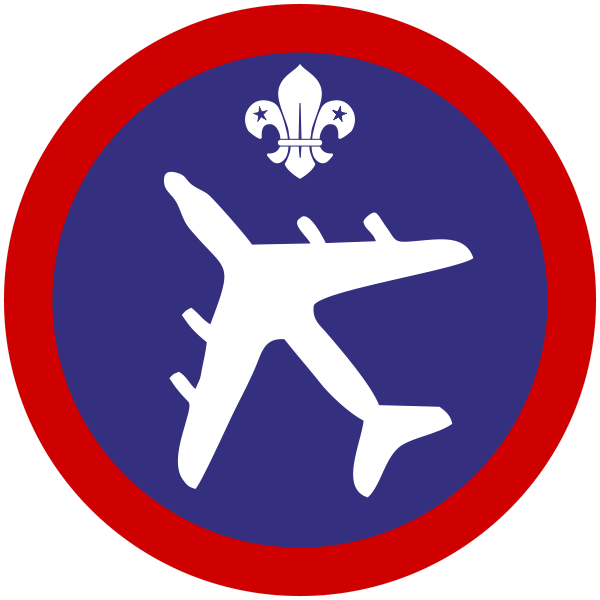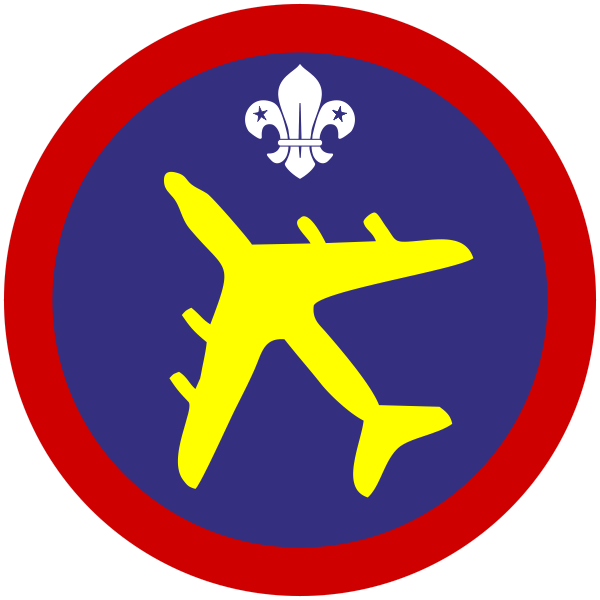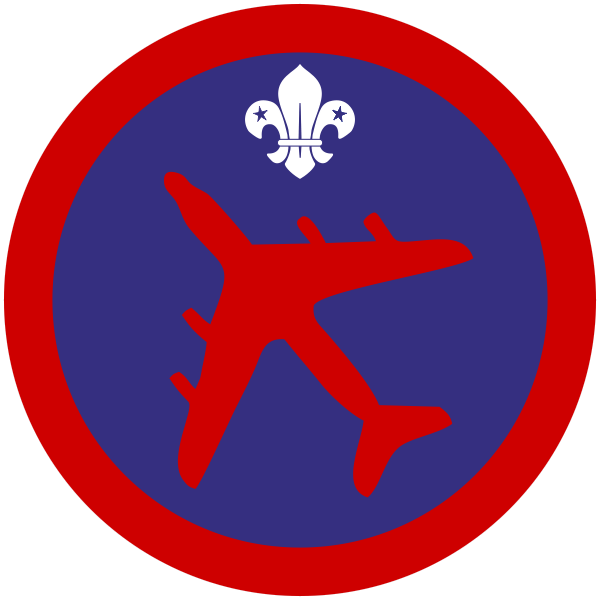




Aviation Skills
Basic Aviation Skills – White Logo
Complete the requirements below:
- Know the rules relating to access to airfields in Policy, Organisation and Rules. Draw a diagram/ map or make a model of an airfield to show and name the different areas.
- Understand the terms: nose, fuselage, tail, main-plane, port and starboard. Know the names of the control surfaces of an aircraft.
- Construct and fly a chuck glider for at least 5 seconds or build and fly a hot-air balloon or kite.
- Choose one of the following activities:
- Collect photographs or pictures of six aircraft that interest you, name them and their operational uses.
- Discuss an airline that you are interested in, or have travelled on, showing pictures of aircraft livery and logos.
- Take part in a Patrol or Troop visit with other Scouts to a place of aviation interest.
- From the list of Aviation Skills training activities complete four items, each to be taken from a different section.
Note:
The Imperial War Museum at Duxford has developed resources for this badge. These can be found on the IWM Duxford website.
Aviation Skills – Yellow Logo
Complete the requirements below:
- Qualify with one of the following:
- Hold the Basic Aviation Skills Badge
- Be at least 11½ years and complete requirements 1 and 5 of the Basic Aviation Skills Badge.
- List the main types of aircraft and identify the parts of an aeroplane.
- Identify 12 aircraft in use today from pictures or in flight. These must include at least two civil commercial aircraft, two military aircraft and two light private aircraft.
- Explain how wind speed and direction are measured and how weather can affect various air activities. Demonstrate how to obtain a local forecast for an air activity.
- Understand the phonetic alphabet, explain why it is used and demonstrate its use.
- Demonstrate ability to trim a suitable model glider to perform a straight glide, stall and specified turn. Explain the relationships between lift, drag, thrust and weight.
- Choose one of the following activities:
- Fly in a light aircraft or glider as a passenger and know the rules in Policy, Organisation and Rules relating to flying.
- Help to organise a visit to an airfield or place of aviation history for a group of Scouts. Explain to your assessor what you would need to tell the Scouts prior to the visit.
- From the list of Aviation Skills training activities complete a further six items taken from at least four different sections.
- OR
Advance Aviation Skills – Red Logo
Complete the requirements below:
- Qualify with one of the following:
- Hold the Aviation Skills Badge
- Be at least 13 years old and complete requirements 1 and 4 of the Aviation Skills Badge.
- Name the main control surfaces of an aeroplane, explain how they work and how they are controlled.
- Choose one of the following two activities:
- Explain the duties of an aircraft marshaller and demonstrate marshalling signals.
- Explain the duties of a crew leader for a glider launch and demonstrate procedure and signals.
- Know the types of air maps and the conventional signs used on them.
- Choose one of the following activities:
- Explain the basic principles of a piston engine, including the four-stroke cycle, with consideration of valve and ignition timing.
- Compare and contrast the main parts and workings of a piston engine and a jet engine.
- Explain the difference between ground speed and air speed and how wind is used in take off and landing. Explain how a wing gives lift. Explain the causes of stalling.
- Take part in an air experience flight and point out on an air map the features that are over flown.
- From the list of Aviation Skills training activities complete another six items from at least four different sections.
- OR
- Choose any means of air travel, for example powered aircraft, glider, balloon, airship.
Aviation Skills Training Activities
Section 1 – Practical Skills
- Build and fly one of the following:
- A rubber-powered model for at least 15 seconds
- A glider for at least 15 seconds
- A model airship
- A hovercraft
- A boomerang
- Build a scale model aircraft to a satisfactory standard from one of the following:
- Plastic kit, plans or photographs. Talk about the aircraft’s key points and history
- By modifying a standard kit, produce a different but authentic version of the aircraft
- Make a solid model where all control surfaces operate and can be used to demonstrate their effect.
- Demonstrate the signals required to launch a manned glider and participate as part of a launch or recovery crew.
- Arrange for a suitably experienced instructor to give training in how a parachute works. Be able to put on a parachute harness and demonstrate the correct landing roll.
- Assist with the launching and recovery of a paraglider. Make two ascents, without release.
- Know the rules in Policy, Organisation and Rules relating to flying and fly in an aircraft as a passenger.
- Undertake a project to demonstrate a particular aeronautical principle and build a suitable model to illustrate it.
- Build and fly at least five different designs of paper aeroplane, using published plans if desired.
- One other activity of a similar nature and level of achievement as agreed by your leadership team.
Section 2 – Flight Safety and Airmanship
- Know the dangers posed to aircraft by birds and other wildlife and the methods employed to reduce the problem.
- Understand the working of an airport fire service or emergency team, the equipment employed and main rescue methods.
- Know the reasons for airport security, the main threats and means of counteracting these threats.
- Explain how an aircraft lifejacket works. Demonstrate its use.
- Draw a runway and its circuit patterns indicating:
- Climb-out; cross wind; down wind; base leg; final leg
- Runway markings
- Taxi-ways; overshoot; under-shoot areas
- Explain and illustrate the purpose and workings of an ejector seat.
- Understand the physical fitness requirements to fly as a pilot or passenger. Be aware of health concerns such as ear blockage, hypoxia and deep vein thrombosis.
- Explain the emergency procedures for a manned glider in the case of:
- Cable failure in a winch or aero-tow launch, and engine failure of a motor glider
- Structural failure or collision at altitude
- Inability to release cable in the case of winch launch or aero-tow
- Altitude loss to the extent that safe soaring is no longer feasible
- Understand the responsibilities of the commander of an aircraft. Examples include briefings, safety of load and passengers, completing relevant paperwork.
- Demonstrate pre-flight inspection of an aircraft and explain why inspection of each part is important to safe operation.
- One other activity of a similar nature and level of achievement as agreed by the leadership team.
Section 3 – Aerospace Operations
- Describe at least six airlines by their names and markings, completing one of the following:
- Identify the home countries and main operating bases
- Describe six routes operated by each airline, together with the aircraft used
- Describe the operations of an all-cargo airline. Know the main types of cargo aircraft and their special applications
- Discuss the design characteristics of a chosen aircraft in relation to its operational role
- Understand the principles of air launched and ground based anti-aircraft weapons and the systems used to counteract them.
- Demonstrate knowledge of air and space surveillance systems, their types and applications.
- Understand the advantage of mid-air refuelling for military aircraft, the main methods of fuel transfer and the main types of tanker used.
- Discuss the problem of aerospace flight including acceleration to escape velocity, the reason for weightlessness and re-entry problems.
- Demonstrate a general knowledge of the progress of space exploration, describing in particular one space programme.
- Understand the principles of re-usable space vehicles. Know their advantages and disadvantages over conventional rocket systems/launch vehicles.
- Explain the roles of two recent space probes and two recently launched satellites, giving the main types of instruments used.
- Demonstrate the scale of the solar system with a drawing or model to show the relative positions of the planets.
- Any other one activity of a similar nature and level of achievement as agreed by the leadership team.
Section 4 – Navigation
- Explain the workings and potential errors of an aircraft compass.
- For a cross-country flight of at least 80 kilometres, work out the time of flight from an overhead starting point to an overhead destination for a given airspeed, assuming, i. a given headwind; ii. a given tailwind.
- Explain the workings of a Global Positioning System (GPS) and be able to demonstrate its usage.
- Explain the workings of aircraft pressure instruments, for example an altimeter or air speed indictor. Explain the sources of errors.
- For a cross-country flight of at least 80 kilometres, determine a heading given a track, wind speed and direction.
- Demonstrate knowledge of conventional symbols used on an aeronautical chart and show how to do simple flight calculations.
- Illustrate latitude and longitude by simple diagrams. Explain the need for different types of map projections.
- Show a basic knowledge of Aeronav aids and equipment. Understand the concept of GPS.
- Any other one activity of a similar nature and level of achievement as agreed by the Section leadership team.
Second 5 – Meteorology
- Identify the basic clouds and explain how they are formed.
- Explain how wind speed is measured and how weather can affect various air activities.
- Demonstrate how to get a local forecast for an air activity.
- Explain the flight conditions that can be expected in various cloud formations and weather conditions.
- Outline how temperature and pressure are measured, list the units used and demonstrate conversions between different units by use of tables and by calculation.
- Identify the weather conditions associated with the movement of air masses over the United Kingdom for example Polar, Tropical, Maritime and Continental..
- Explain how readings of upper air conditions are obtained.
- Collect detailed weather maps of the United Kingdom either from the internet or from a newspaper for a two-week period. Illustrate the development of significant weather features over this period.
- Be able to interpret Met Office reports and forecasts for pilots, such as METAR and TAF.
- Any other one activity of a similar nature and level of achievement as agreed by the Section leadership team.
Section 6 – Aero Engines
- Explain how jets or rockets obtain thrust. Explain the principle of the ramjet. Explain the principles of a centrifugal or axial compressor type jet engine and identify the main components of such an engine.
- Discuss the relative merits of piston engines, turbojets, turboprops, turbofans, ramjets and rockets.
- Identify the main types of aircraft fuels and fuel systems.
- Demonstrate knowledge of the causes of aircraft noise and disturbance. Know the design methods used to reduce aircraft noise and how the effects on local communities can be reduced.
- Demonstrate knowledge of the effect of aircraft engine emissions on the atmosphere and how these can be reduced.
- Any other one activity of a similar nature and level of achievement as agreed by the Section leadership team.
Section 7 – Communications and Air Traffic Control
- Identify the signals used on an airfield signals square, together with runway and airfield markings.
- Identify the lamp and pyrotechnic signals used on an airfield.
- Understand why Morse code is still transmitted by navigational beacons and be able to recognise six three-letter sequences either from a recording or written copy.
- Explain the system of air traffic control in use at a small civilian airfield.
- Demonstrate examples of the ground-to-air emergency code.
- Understand the special communications difficulties for activities such as paragliding or hang gliding and the need for clearance in areas of military flying.
- Any other one activity of a similar nature and level of achievement as agreed by your leadership team.
Section 8 – Principles of Flight
- Explain the meaning of trim and the importance of weight and balance.
- Explain the purpose and operation of flaps, slots and slats.
- Explain how basic aerobatic manoeuvres are carried out.
- Demonstrate knowledge of the principles of take-off and landing with special reference to light aircraft.
- Explain the methods by which short or vertical take-off can be achieved.
- Describe the airflow around a modern square parachute, explaining how it develops lift and how it is controlled.
- Attain a reasonable standard on a home computer flight simulator programme and understand why the aircraft behaves as it does. The suitability of the programme is to be agreed by the Section leadership team.
- Show knowledge of the methods for operating specialised passenger aircraft into city centres such as helicopters, STOL, tilt wing etc and the main drawbacks
- Any other one activity of a similar nature and level of achievement by your leadership team.
